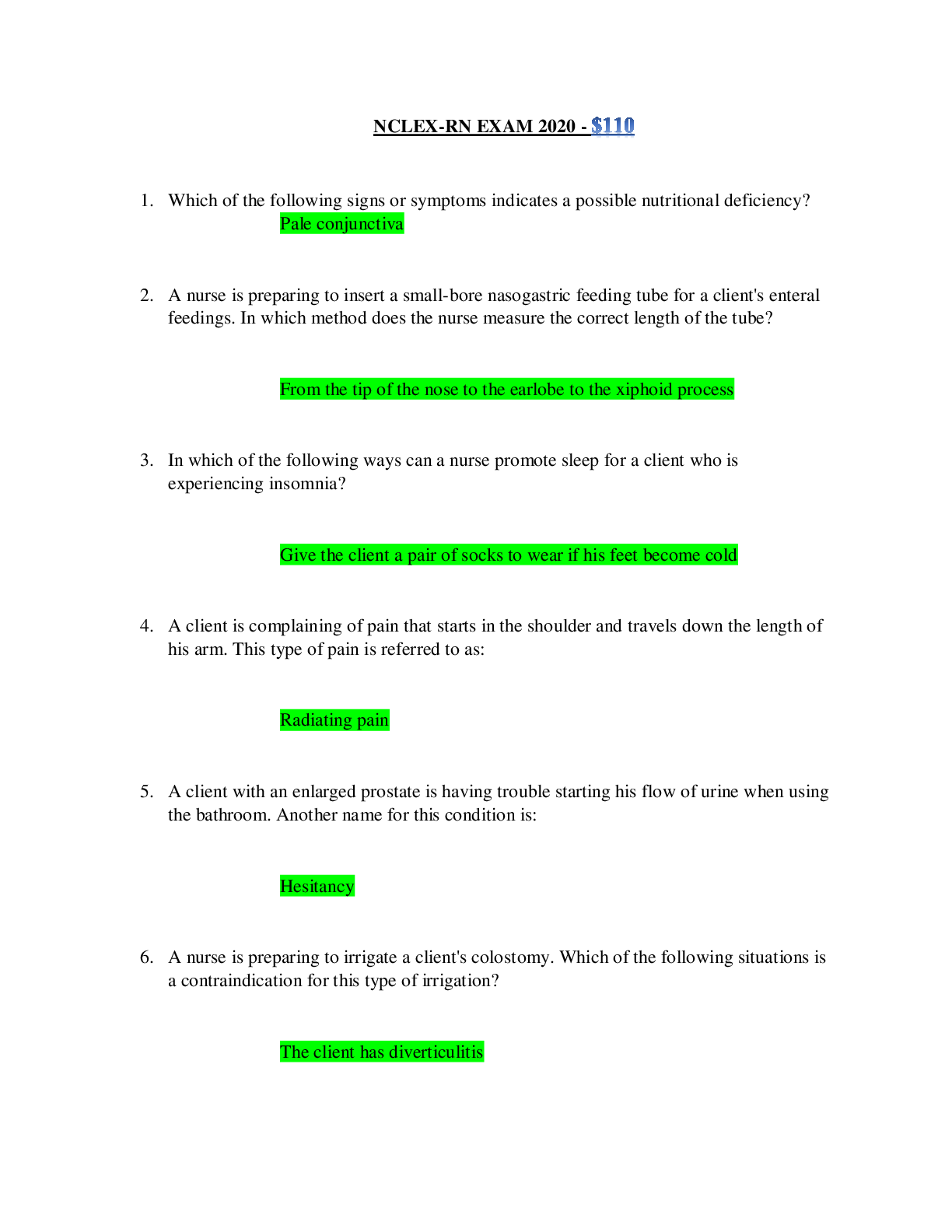*NURSING > NCLEX-RN > C H A P T E R 1 2 Health and Physical Assessment of the Adult Client: From Saunders Comprehensive Re (All)
C H A P T E R 1 2 Health and Physical Assessment of the Adult Client: From Saunders Comprehensive Review for the NCLEX-RN Examination 8th Edition. (Available: https://bit.ly/2HeJuMt ). Contains Practice questions and Answers with the Rationale, Test-Taking Strategy, Level of Cognitive Ability, Client Needs, Integrated Process, Content Area, Health Problem, Priority Concepts and Reference
Document Content and Description Below
Priority Concepts Clinical Judgment; Health Promotion I. Environment/Setting A. Establish a relationship and explain the procedure to the client. B. Ensure privacy and make the client feel comfort... able (comfortable room temperature, sufficient lighting, remove distractions such as noise or objects, and avoid interruptions). C. Sit down for the interview (avoid barriers such as a desk), maintain an appropriate social distance, and maintain eye level. D. Use therapeutic communication techniques and open-ended questions to obtain information about the client’s symptoms and concerns; allow time for the client to ask questions. E. Consider religious and cultural characteristics such as language (the need for an interpreter), values and beliefs, health practices, eye contact, and touch. F. Keep note-taking to a minimum so the client is the focus of attention. G. Types of health and physical assessments (Box 12-1) H. SOAP (subjective, objective, assessment, plan) notes are a frequently used format for documenting client data including health history, physical examination, assessment or diagnosis, and plan of care. The nurse should be familiar with SOAP notes, how to interpret the initial history and physical (H&P) SOAP notes, and how to follow subsequent progress SOAP notes so as to maintain abreast of changes in the client’s plan of care. See Table 12-1 for a detailed list of information contained in SOAP notes. II. Health History (refer to section titled “Subjective” in Table 12-1) A. General state of health: Body features and physical characteristics, body movements, body posture, level of consciousness, nutritional status, speech B. Chief complaint and history of present illness (document 362direct client quotes) that leads the client to seek care C. Family history: The health status of direct blood relatives as well as the client’s spouse D. Social history 1. Data about the client’s lifestyle, with a focus on factors that may affect health 2. Information about alcohol, drug, and tobacco use; sexual practices; tattoos; body piercing; travel history; and work setting to identify occupational hazards E. Domestic violence screening 1. Done to determine whether the client is experiencing any form of domestic violence 2. Conducted during a one-to-one interview with the client while obtaining the health history III. Mental Status Exam A. The mental status can be assessed while obtaining subjective data from the client during the health history interview. B. Appearance 1. Note appearance, including posture, body movements, dress, and hygiene and grooming. 2. An inappropriate appearance and poor hygiene may be indicative of depression, manic disorder, dementia, organic brain disease, or another disorder. C. Behavior 1. Level of consciousness: Assess alertness and awareness and the client’s ability to interact appropriately with the environment. 2. Facial expression and body language: Check for appropriate eye contact and determine whether facial expression and body language are appropriate to the situation; this assessment also provides information regarding the client’s mood and affect. 3. Speech: Assess speech pattern for articulation and appropriateness of conversation. D. Cognitive level of functioning (Box 12-2) IV. Physical Exam (refer to section titled “Objective” in Table 12-1) A. Overview 1. Gather equipment needed for the examination. 2. Use the senses of sight, smell, touch, and hearing to collect data. 3. Assessment includes inspection, palpation, percussion, and auscultation; these skills are performed one at a time, in this order (except the 363abdominal assessment). B. Assessment techniques 1. Inspection a. The first assessment technique, which uses vision and smell senses while observing the client b. Requires good lighting, adequate body exposure with draping, and possibly the use of certain instruments such as an otoscope or ophthalmoscope 2. Palpation a. Uses the sense of touch; warm the hands before touching the client. b. Identify tender areas and palpate them last. c. Start with light palpation to detect surface characteristics, and then perform deeper palpation. d. Light palpation is done with 1 hand by pressing the skin gently with the tips of 2 or 3 fingers held close together; deep palpation is done by placing 1 hand on top of the other and pressing down with the fingertips of both hands. e. Assess texture, temperature, and moisture of the skin, as well as organ location and size and symmetry if appropriate. f. Assess for swelling, vibration or pulsation, rigidity or spasticity, and crepitation. g. Assess for the presence of lumps or masses, as well as the presence of tenderness or pain. 3. Percussion a. Involves tapping the client’s skin to assess underlying structures and to determine the presence of vibrations and sounds and, if present, their intensity, duration, pitch, quality, and location b. Provides information related to the presence of air, fluid, or solid masses as well as organ size, shape, and position c. Descriptions of findings include 364resonance, hyperresonance, tympany, dullness, or flatness. 4. Auscultation: Involves listening with a stethoscope to sounds produced by the body for presence and quality, such as heart, lung, or bowel sounds C. Vital signs 1. Includes temperature, radial pulse (apical pulse may be measured during the cardiovascular assessment), respirations, blood pressure, pulse oximetry, and presence of pain (refer to Chapter 10 for information on vital signs, pulse oximetry, and pain) 2. Height, weight, and nutritional status are also assessed. V. Body Systems Assessment A. Integumentary system: Involves inspection and palpation of skin, hair, and nails. 1. Subjective data: Self-care behaviors, history of skin disease, medications being taken, environmental or occupational hazards and exposure to toxic substances, changes in skin color or pigmentation, change in a mole or a sore that does not heal 2. Objective data: Color, temperature (hypothermia or hyperthermia); excessive dryness or moisture; skin turgor; texture (smoothness, firmness); excessive bruising, itching, rash; hair loss (alopecia) or nail abnormalities such as pitting; lesions (may be inspected with a magnifier and light or with the use of a Wood’s light [ultraviolet light used in a darkened room]); scars or birthmarks; edema; capillary filling time (Boxes 12-3 and 12-4; Table 12-2) 3. Dark-skinned client a. Cyanosis: Check lips and tongue for a gray color; nailbeds, palms, and soles for a blue color; and conjunctivae for pallor. b. Jaundice: Check oral mucous membranes for a yellow color; check the sclera nearest to the iris for a yellow color. c. Bleeding: Look for skin swelling and darkening and compare the affected side with the unaffected side. d. Inflammation: Check for warmth or a shiny or taut and pitting skin area, and compare with the unaffected side. 3654. Refer to Chapter 42 for diagnostic tests related to the integumentary system To test skin turgor, pinch a large fold of skin and assess the ability of the skin to return to its place when released. Poor turgor occurs in severe dehydration or extreme weight loss. 5. Client teaching a. Provide information about factors that can be harmful to the skin, such as sun exposure. b. Encourage performing self-examination of the skin for lesions monthly using the ABCDE (asymmetry, border irregularity, color variance, diameter greater than 6 mm, evolving size, shape, and color) mnemonic. B. Head, neck, and lymph nodes: Involves inspection, palpation, and auscultation of the head, neck, and lymph nodes 1. Ask the client about headaches; episodes of dizziness (lightheadedness) or vertigo (spinning sensation); history of head injury; loss of consciousness; seizures; episodes of neck pain; limitations of range of motion; numbness or tingling in the shoulders, arms, or hands; lumps or swelling in the neck; difficulty swallowing; medications being taken; and history of surgery in the head and neck region. 2. Head a. Inspect and palpate: Size, shape, masses or tenderness, and symmetry of the skull b. Palpate temporal arteries, located above the cheekbone between the eye and the top of the ear. c. Palpate frontal and maxillary sinuses for tenderness. d. Temporomandibular joint: Ask the client to open his or her mouth and move it from side to side; note any crepitation, tenderness, or limited range of motion. This tests cranial nerve V, the trigeminal nerve. e. Face: Inspect facial structures for shape, symmetry, involuntary movements, or swelling, such as periorbital edema (swelling around the eyes). 3663. Neck a. Inspect for symmetry of accessory neck muscles. b. Assess range of motion. c. Test cranial nerve XI (spinal accessory nerve) to assess muscle strength: Ask the client to push against resistance applied to the side of the chin (tests sternocleidomastoid muscle); also ask the client to shrug the shoulders against resistance (tests trapezius muscle). d. Palpate the trachea: It should be midline, without any deviations. e. Thyroid gland: Inspect the neck as the client takes a sip of water and swallows (thyroid tissue moves up with a swallow); palpate using an anterior-posterior approach (usually the normal adult thyroid cannot be palpated); if it is enlarged, auscultate for a bruit. 4. Lymph nodes a. Palpate using a gentle pressure and a circular motion of the finger pads. b. Begin with the preauricular lymph nodes (in front of the ear); move to the posterior auricular lymph nodes and then downward toward the supraclavicular lymph nodes. Lymph nodes in the head and neck area to be palpated include preauricular, postauricular, tonsillar, submandibular, submental, anterior cervical chain (superficial and deep), posterior cervical chain, supraclavicular, and infraclavicular. c. Palpate with both hands, comparing the 2 sides for symmetry. d. If nodes are palpated, note their size, shape, location, mobility, consistency, and tenderness. 5. Client teaching: Instruct the client to notify the primary health care provider (PHCP) if persistent headache, dizziness, or neck pain occurs; if swelling 367or lumps are noted in the head and neck region; or if a neck or head injury occurs. Neck movements are never performed if the client has sustained a neck injury or if a neck injury is suspected. C. Eyes: Includes inspection, palpation, vision-testing procedures, and the use of an ophthalmoscope 1. Subjective data: Difficulty with vision (e.g., decreased acuity, double vision, blurring, blind spots); pain, redness, swelling, watery or other discharge from the eye; use of glasses or contact lenses; medications being taken; history of eye problems 2. Objective data a. Inspect the external eye structures, including eyebrows, for symmetry; eyelashes for even distribution; eyelids for ptosis (drooping); eyeballs for exophthalmos (protrusion) or enophthalmos (recession into the orbit; sunken eye). b. Inspect the conjunctiva (should be clear), sclera (should be white), and lacrimal apparatus (check for excessive tearing, redness, tenderness, or swelling); cornea and lens (should be smooth and clear); iris (should be flat, with a round regular shape and even coloration); eyelids; and pupils. 3. Snellen eye chart a. The Snellen eye chart is a simple tool used to measure distance vision. b. Position the client in a well-lit spot 20 feet (6 meters) from the chart, with the chart at eye level, and ask the client to read the smallest line that he or she can discern. c. Instruct the client to leave on glasses or leave in contact lenses; if the glasses are for reading only, they are removed because they blur distance vision. d. Test 1 eye at a time, cover the eye not 368being tested. e. Record the result using the fraction at the end of the last line successfully read on the chart. f. Normal visual acuity is 20/20 (distance in feet at which the client is standing from the chart/distance in feet at which a normal eye could have read that particular line). g. This assessment tests cranial nerve II, the optic nerve. 4. Near vision a. Use a handheld vision screener (held about 14 inches [35.5 cm] from the eye) that contains various sizes of print or ask the client to read from a magazine. b. Test each eye separately with the client’s glasses on or contact lenses in. Cover the eye not being tested. c. Normal result is 14/14 (distance in inches at which the subject holds the card from the eye/distance in inches at which a normal eye could have read that particular line). d. This assessment tests cranial nerve II, the optic nerve. 5. Confrontation test a. A crude but rapid test used to measure peripheral vision and compare the client’s peripheral vision with the nurse’s (assuming that the nurse’s peripheral vision is normal) b. The client covers 1 eye and looks straight ahead; the nurse, positioned 2 feet away (60 cm), covers his or her eye opposite the client’s covered eye. c. The nurse advances a finger or other small object from the periphery from several directions; the client should see the object at the same time the nurse does. d. Documented as the client’s peripheral vision is equal to that of the examiner’s. e. This assessment tests cranial nerve II, the optic nerve. 6. Corneal light reflex a. Used to assess for parallel alignment of 369the axes of the eyes b. Client is asked to gaze straight ahead as the nurse holds a light about 12 inches (30 cm) from the client. c. The nurse looks for reflection of the light on the corneas in exactly the same spot in each eye. 7. Cover/uncover test a. Used to check for slight degrees of deviated alignment b. Each eye is tested separately. c. The nurse asks the client to gaze straight ahead and cover 1 eye. d. The nurse examines the uncovered eye, expecting to note a steady, fixed gaze. 8. Diagnostic positions test (6 cardinal positions of gaze) (Fig. 12-1) a. The 6 muscles that attach the eyeball to its orbit and serve to direct the eye to points of interest are tested. b. Client holds head still and is asked to move his or her eyes and follow a small object. c. The examiner notes any parallel movements of the eye or nystagmus, an involuntary, rhythmic, rapid twitching of the eyeballs. d. This assessment tests cranial nerves III, IV, and VI, oculomotor, trochlear, and abducens, respectively. 9. Color vision a. Tests for color vision involve the client picking numbers or letters out of a complex and colorful picture using what is known as the Ishihara chart. b. The test is sensitive for the diagnosis of red-green blindness but cannot detect discrimination of blue. The first slide on the Ishihara chart is one that everyone can discriminate; failure to identify numbers on this slide suggests a problem with performing the test, not a problem with color vision. 10. Pupils (Box 12-5) a. The pupils are round and of equal size. b. Increasing light causes pupillary 370constriction. c. Decreasing light causes pupillary dilation. d. Constriction of both pupils is a normal response to direct light. Constriction of the pupil in which the light is being shone is considered reaction to direct light, and constriction of the pupil in which the light is not being shone is considered reaction to consensual light. 11. Sclera and cornea a. Normal sclera color is white. b. A yellow color to the sclera may indicate jaundice or systemic problems. c. In a dark-skinned person, the sclera may normally appear yellow; pigmented dots may be present. d. The cornea is transparent, smooth, shiny, and bright. e. Cloudy areas or specks on the cornea may be the result of an accident or eye injury. 12. Ophthalmoscopy or fundoscopy a. The ophthalmoscope, or funduscope, is an instrument used to examine the external structures and the interior of the eye. b. The room is darkened so that the pupil will dilate. c. The instrument is held with the right hand when examining the right eye and with the left hand when examining the left eye. d. The client is asked to look straight ahead at an object on the wall. e. The examiner should approach the client’s eye from about 12 to 15 inches (30.5 to 38 cm) away and 15 degrees lateral to the client’s line of vision. f. As the instrument is directed at the pupil, a red glare (red reflex) is seen in the pupil. g. The red reflex is the reflection of light on the vascular retina. h. Absence of the red reflex may indicate opacity of the lens. 371 Practice Questions 90. A Spanish-speaking client arrives at the triage desk in the emergency department and states to the nurse that an interpreter is needed. Which is the best action for the nurse to take? 1. Have one of the client’s family members interpret. 2. Have the Spanish-speaking triage receptionist interpret. 3. Page an interpreter from the hospital’s interpreter services. 4. Obtain a Spanish-English dictionary and attempt to triage the client. 91. The nurse is performing a neurological assessment on a client and notes a positive Romberg’s test. The nurse makes this determination based on which observation? 1. An involuntary rhythmic, rapid, twitching of the eyeballs 2. A dorsiflexion of the great toe with fanning of the other toes 3. A significant sway when the client stands erect with feet together, arms at the side, and the eyes closed 4. A lack of normal sense of position when the client is unable to return extended fingers to a point of reference 92. The nurse notes documentation that a client is exhibiting Cheyne-Stokes respirations. On assessment of the client, the nurse should expect to note which finding? 4071. Rhythmic respirations with periods of apnea 2. Regular rapid and deep, sustained respirations 3. Totally irregular respiration in rhythm and depth 4. Irregular respirations with pauses at the end of inspiration and expiration 93. A client diagnosed with conductive hearing loss asks the nurse to explain the cause of the hearing problem. The nurse plans to explain to the client that this condition is caused by which problem? 1. A defect in the cochlea 2. A defect in cranial nerve VIII 3. A physical obstruction to the transmission of sound waves 4. A defect in the sensory fibers that lead to the cerebral cortex 94. While performing a cardiac assessment on a client with an incompetent heart valve, the nurse auscultates a murmur. The nurse documents the finding and describes the sound as which? 1. Lub-dub sounds 2. Scratchy, leathery heart noise 3. A blowing or swooshing noise 4. Abrupt, high-pitched snapping noise 95. The nurse is testing the extraocular movements in a client to assess for muscle weakness in the eyes. The nurse should implement which assessment technique to assess for muscle weakness in the eye? 1. Test the corneal reflexes. 2. Test the 6 cardinal positions of gaze. 3. Test visual acuity, using a Snellen eye chart. 4. Test sensory function by asking the client to close the eyes and then lightly touching the forehead, cheeks, and chin. 96. The nurse is instructing a client how to perform a testicular self-examination (TSE). The nurse should explain that which is the best time to perform this exam? 1. After a shower or bath 2. While standing to void 3. After having a bowel movement 4. While lying in bed before arising 97. The nurse is assessing a client suspected of having meningitis for meningeal irritation and elicits a positive Brudzinski’s sign. Which finding did the nurse observe? 1. The client rigidly extends the arms with pronated forearms and plantar flexion of the feet. 2. The client flexes a leg at the hip and knee and reports pain in the vertebral column when the leg is extended. 3. The client passively flexes the hip and knee in response to neck flexion and reports pain in the vertebral column. 4. The client’s upper arms are flexed and held tightly to the sides of the body and the legs are extended and internally rotated. 98. A client with a diagnosis of asthma is admitted to the hospital with respiratory distress. Which type of adventitious lung sounds should the nurse expect to hear when performing a respiratory assessment on this 408client? 1. Stridor 2. Crackles 3. Wheezes 4. Diminished 99. The clinic nurse prepares to perform a focused assessment on a client who is complaining of symptoms of a cold, a cough, and lung congestion. Which should the nurse include for this type of assessment? Select all that apply. 1. Auscultating lung sounds 2. Obtaining the client’s temperature 3. Assessing the strength of peripheral pulses 4. Obtaining information about the client’s respirations 5. Performing a musculoskeletal and neurological examination 6. Asking the client about a family history of any illness or disease [Show More]
Last updated: 1 year ago
Preview 1 out of 52 pages
Instant download

Instant download
Reviews( 0 )
Document information
Connected school, study & course
About the document
Uploaded On
Oct 22, 2020
Number of pages
52
Written in
Additional information
This document has been written for:
Uploaded
Oct 22, 2020
Downloads
0
Views
64

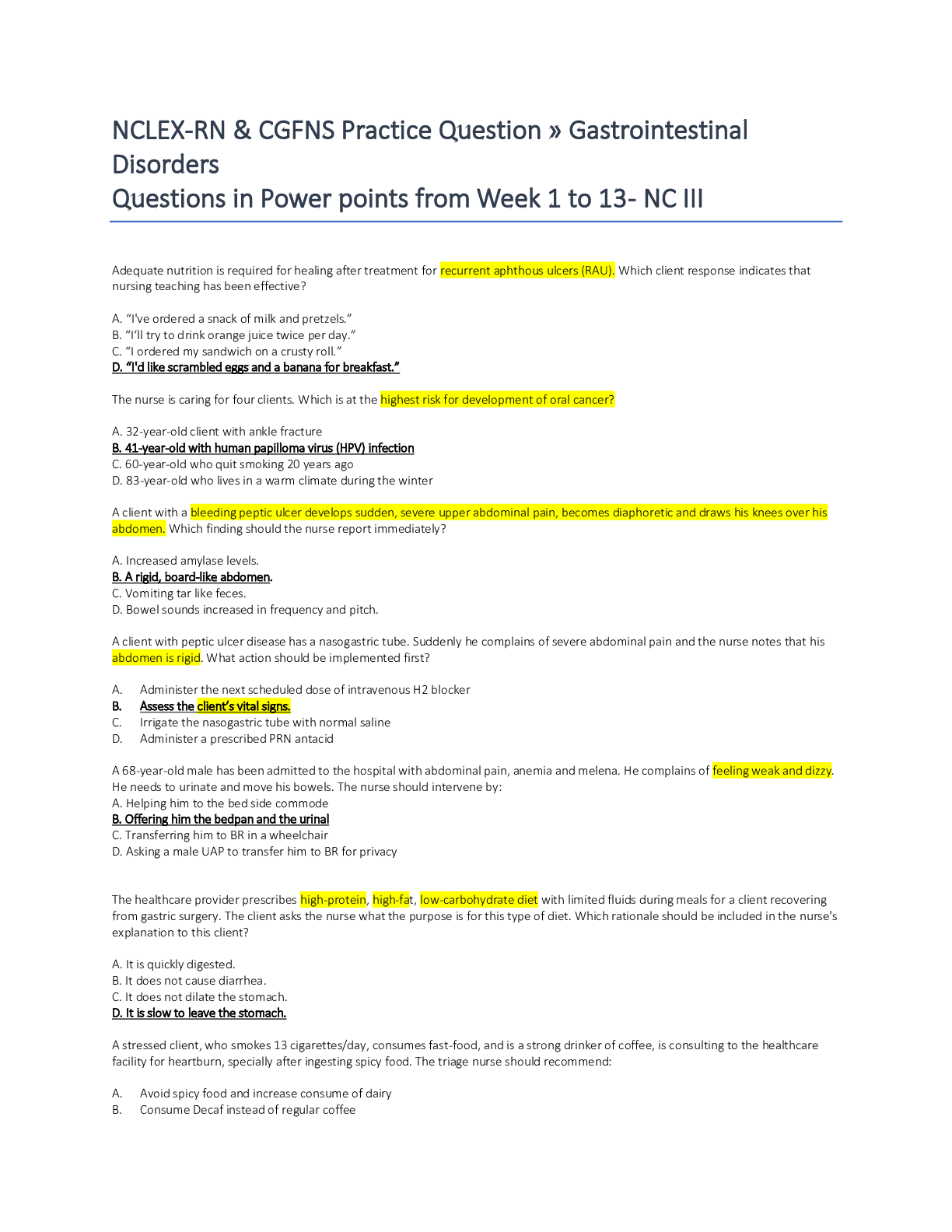
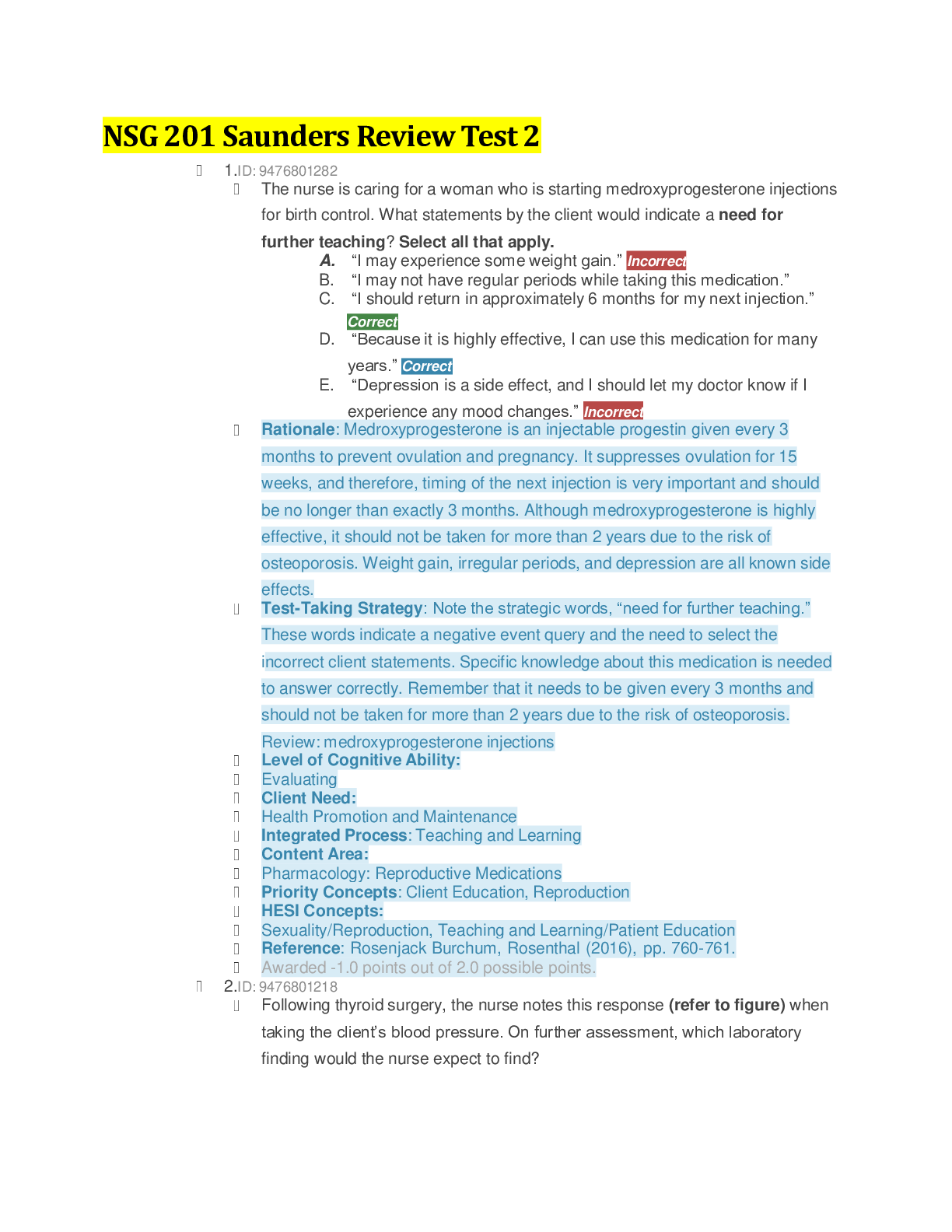
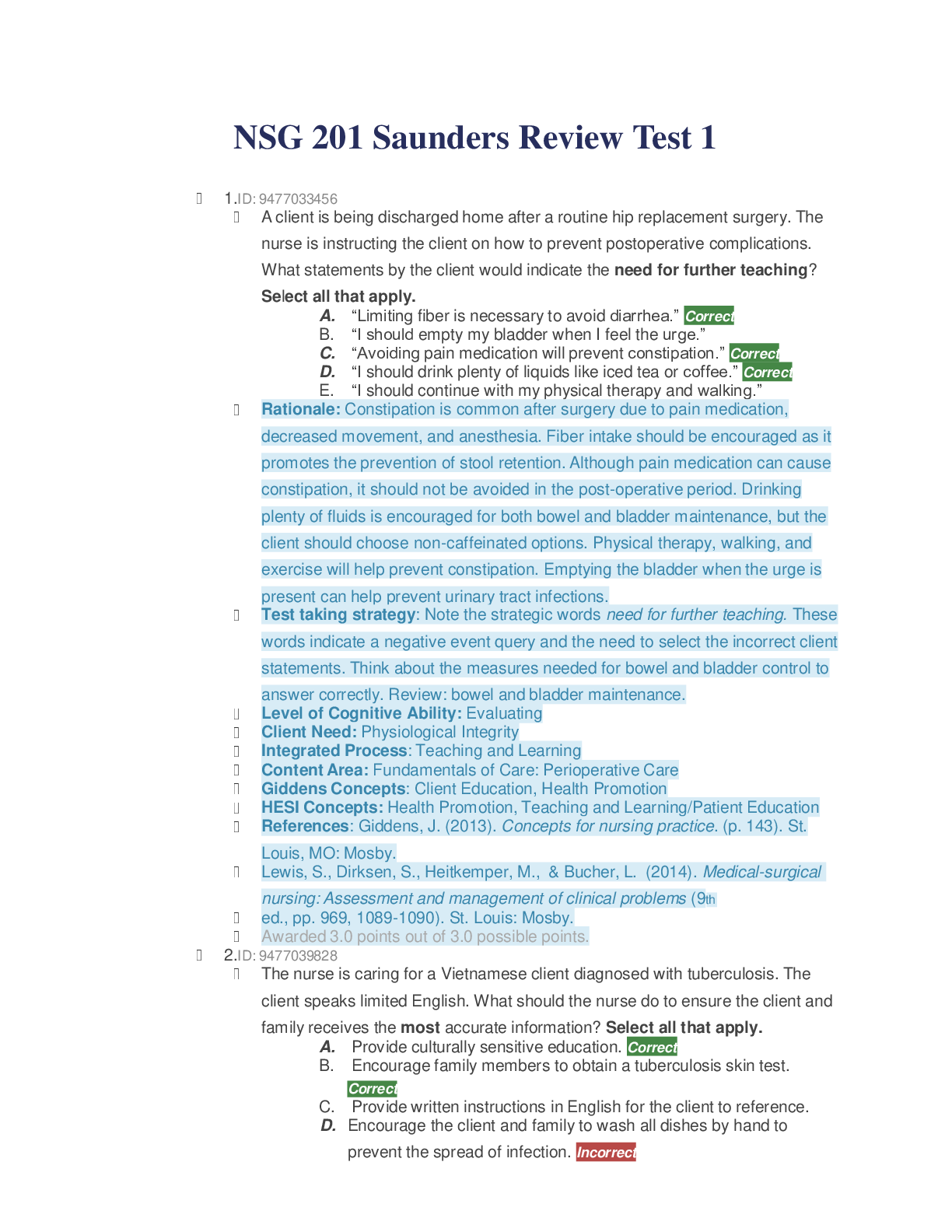
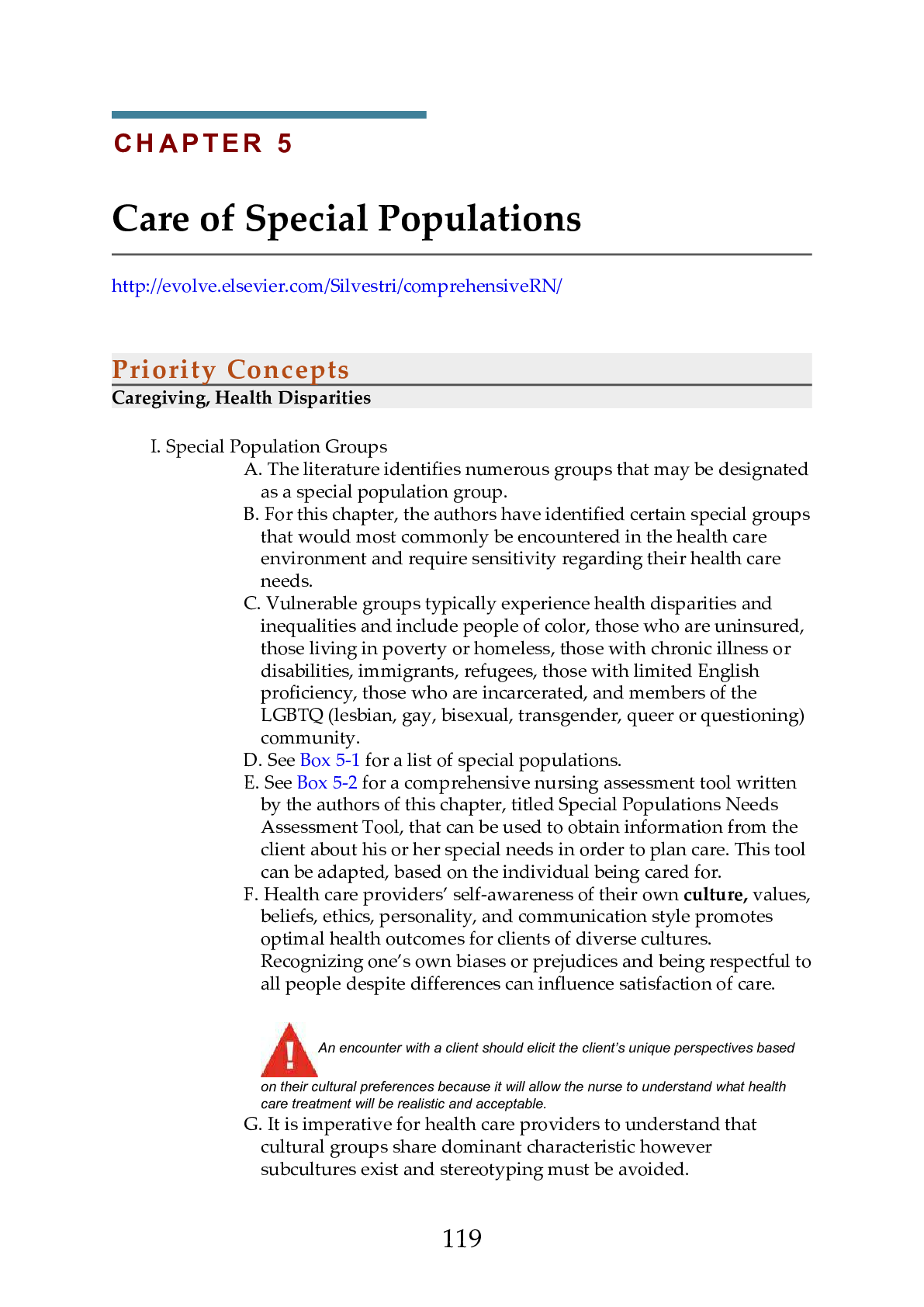
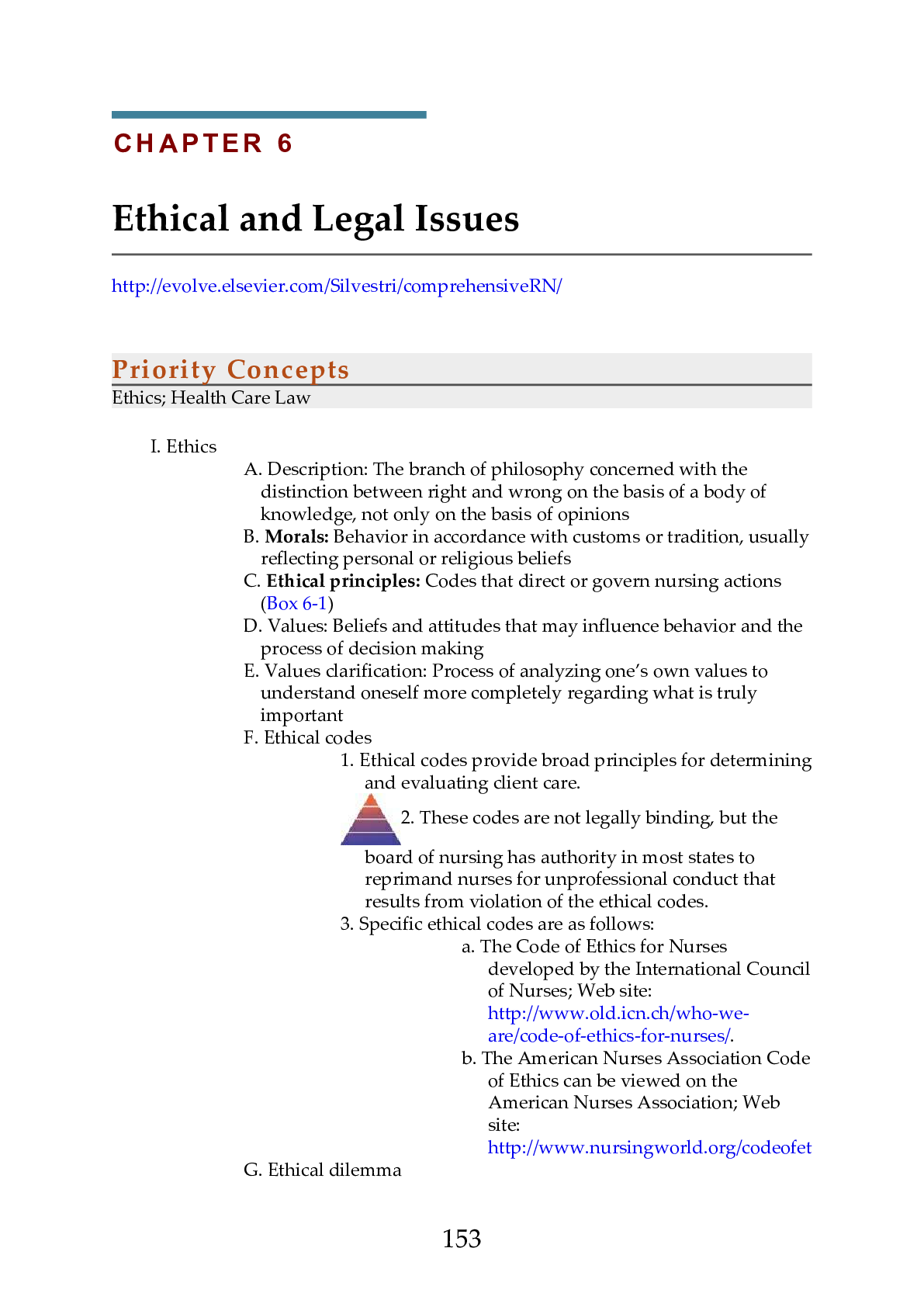
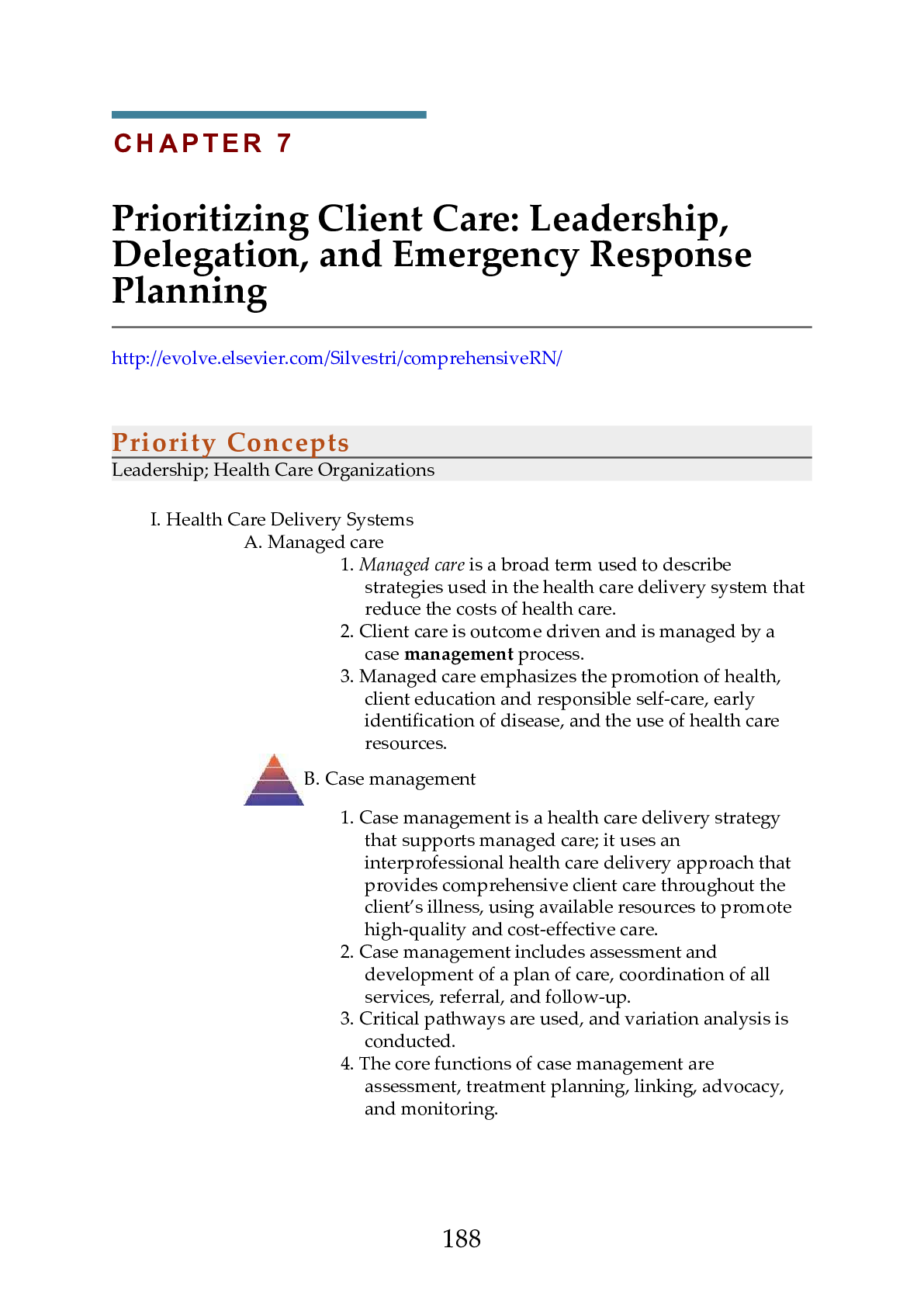
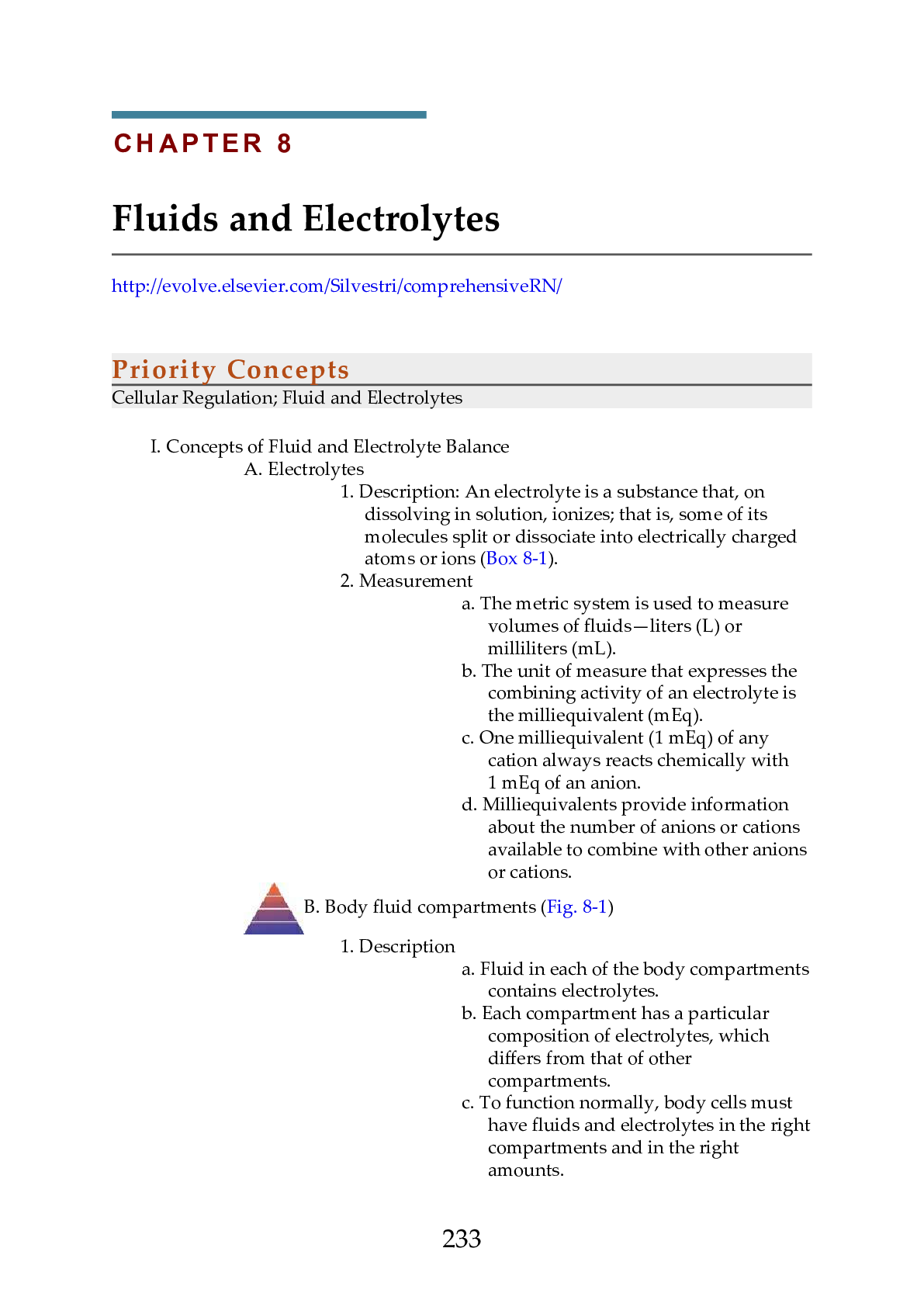
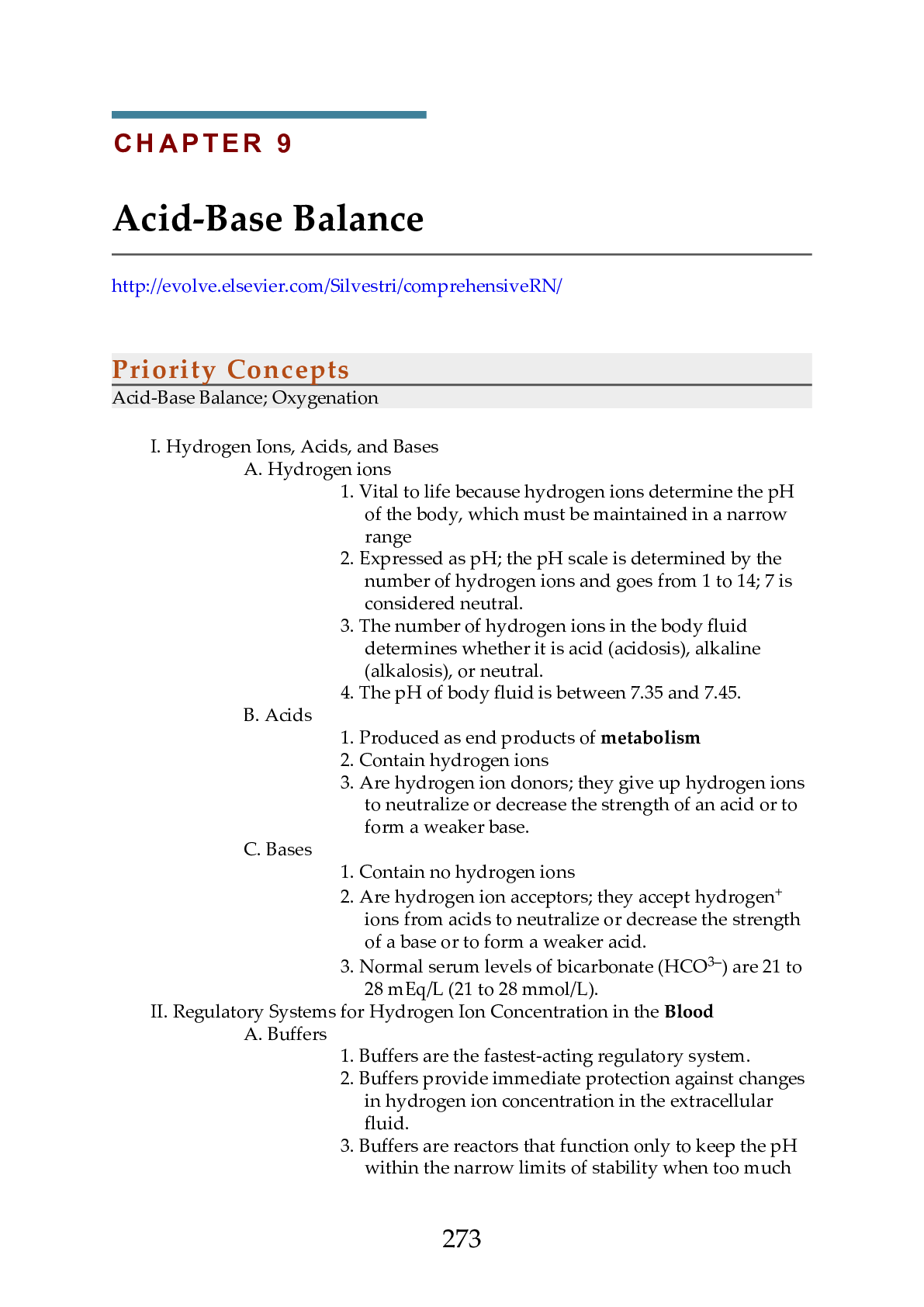

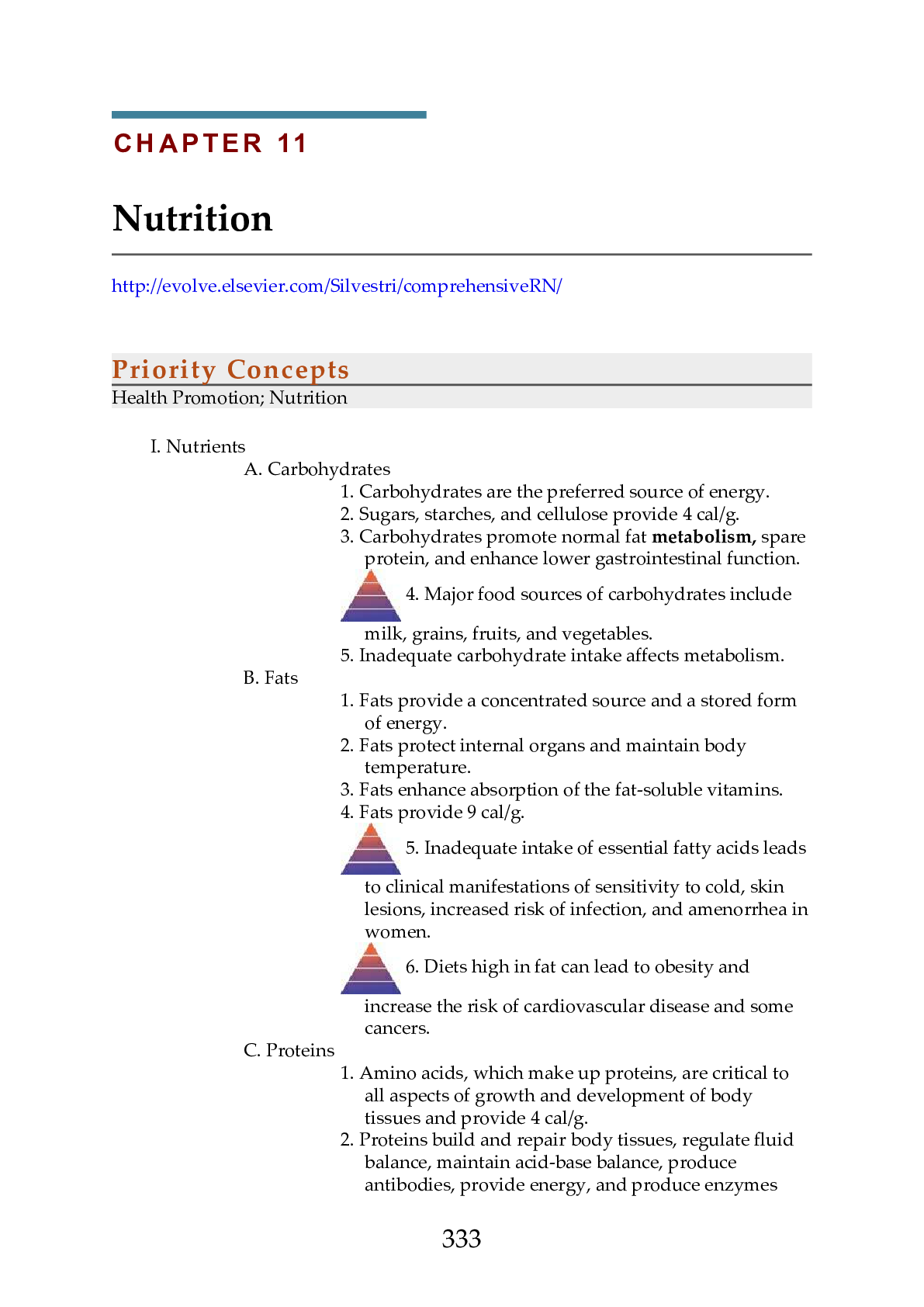
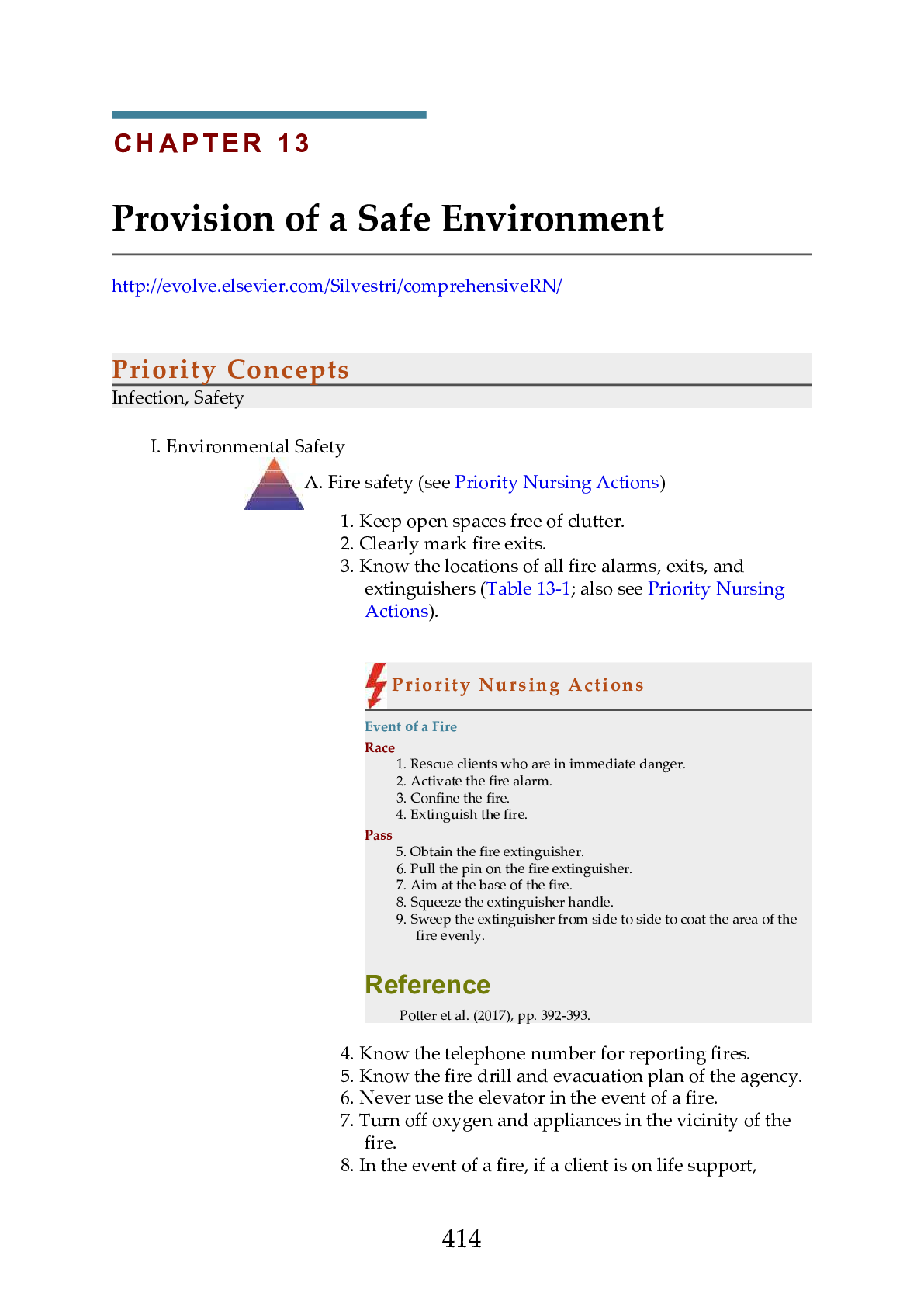



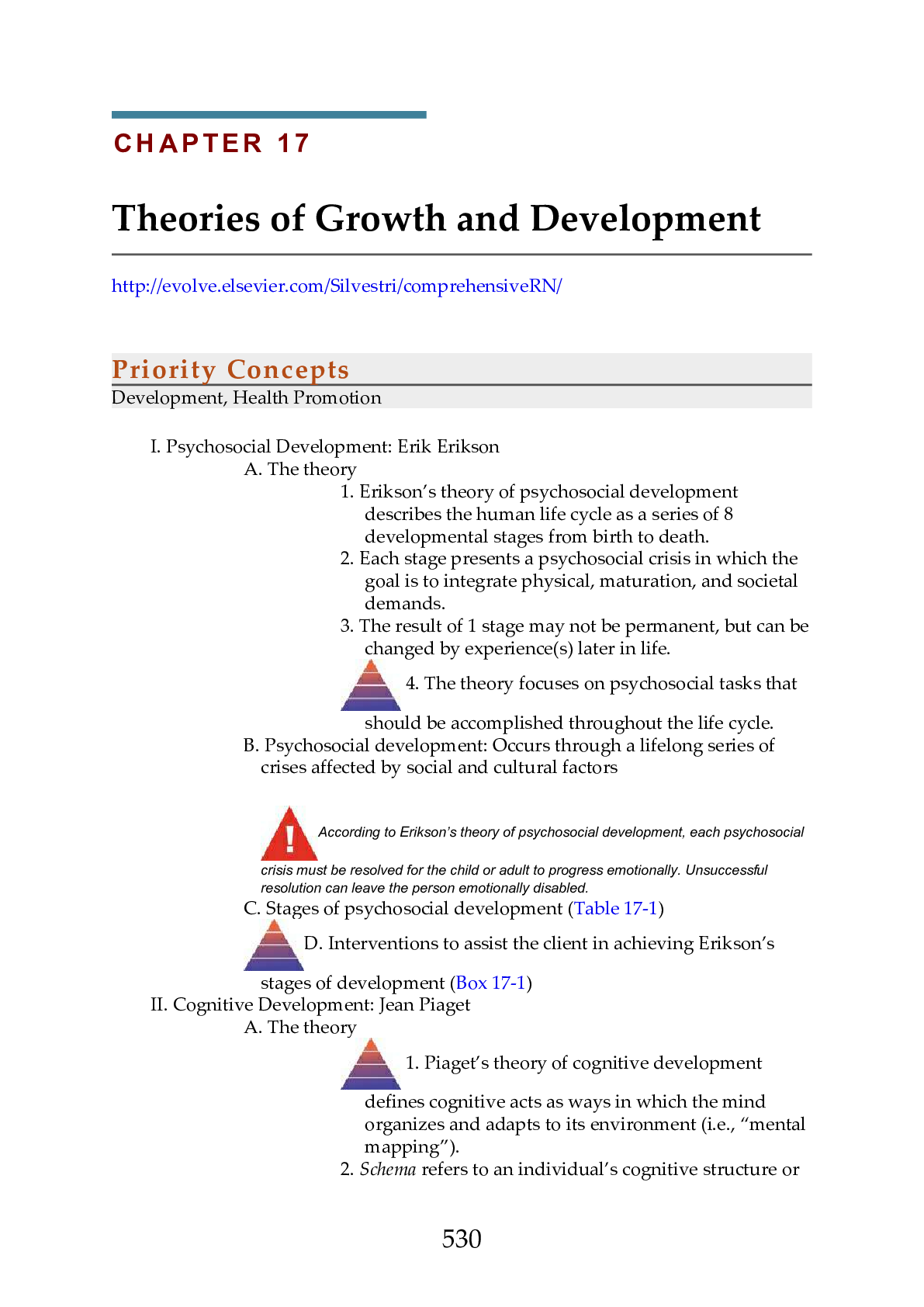

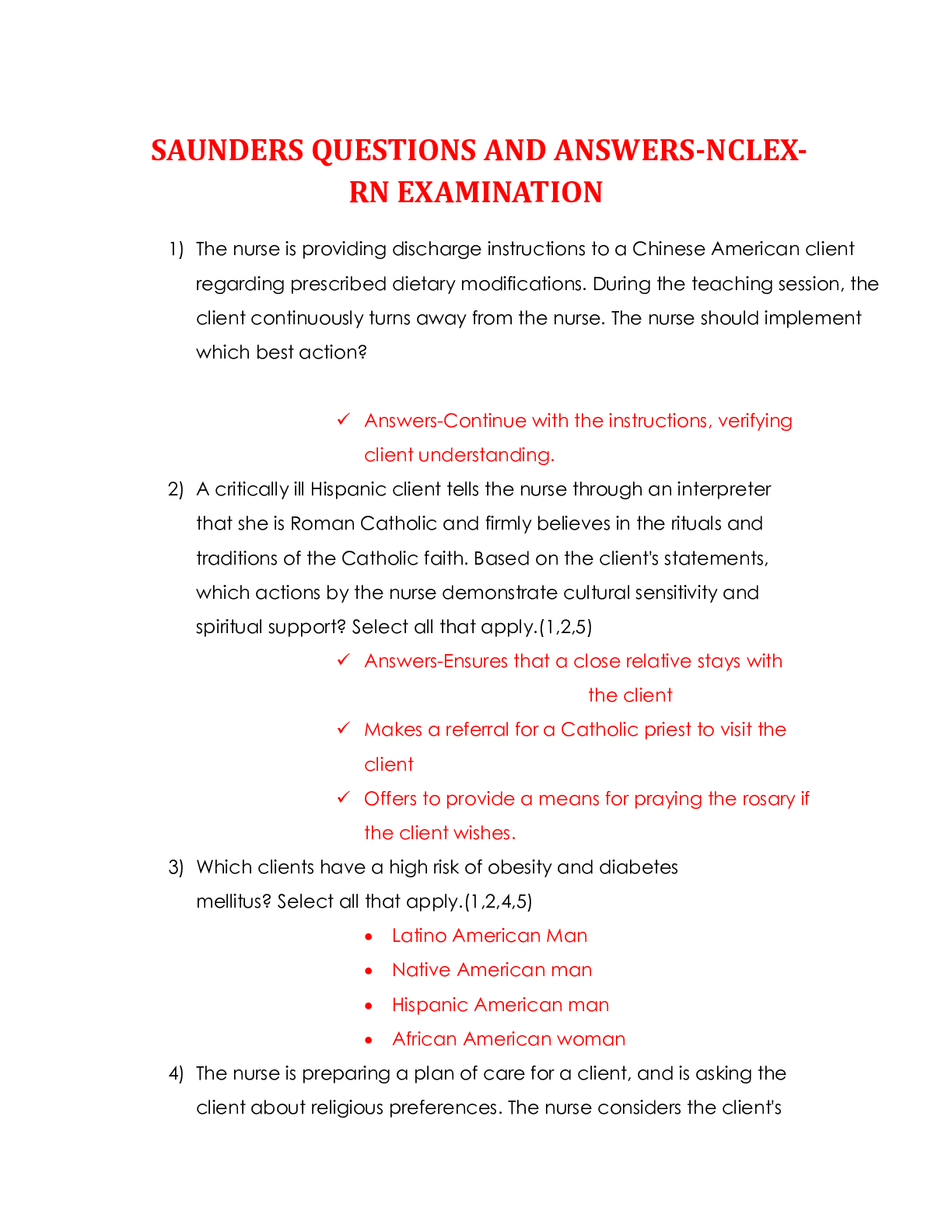
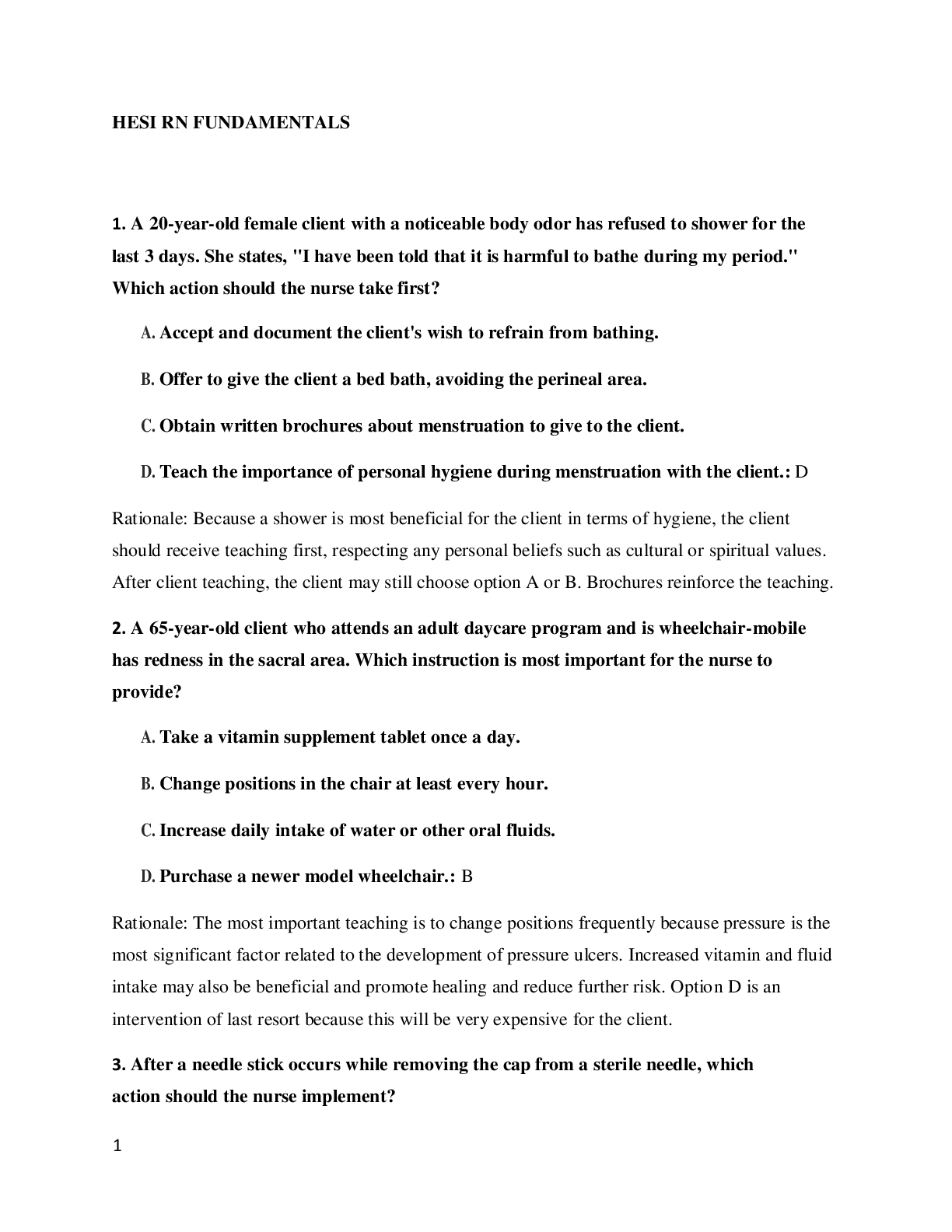
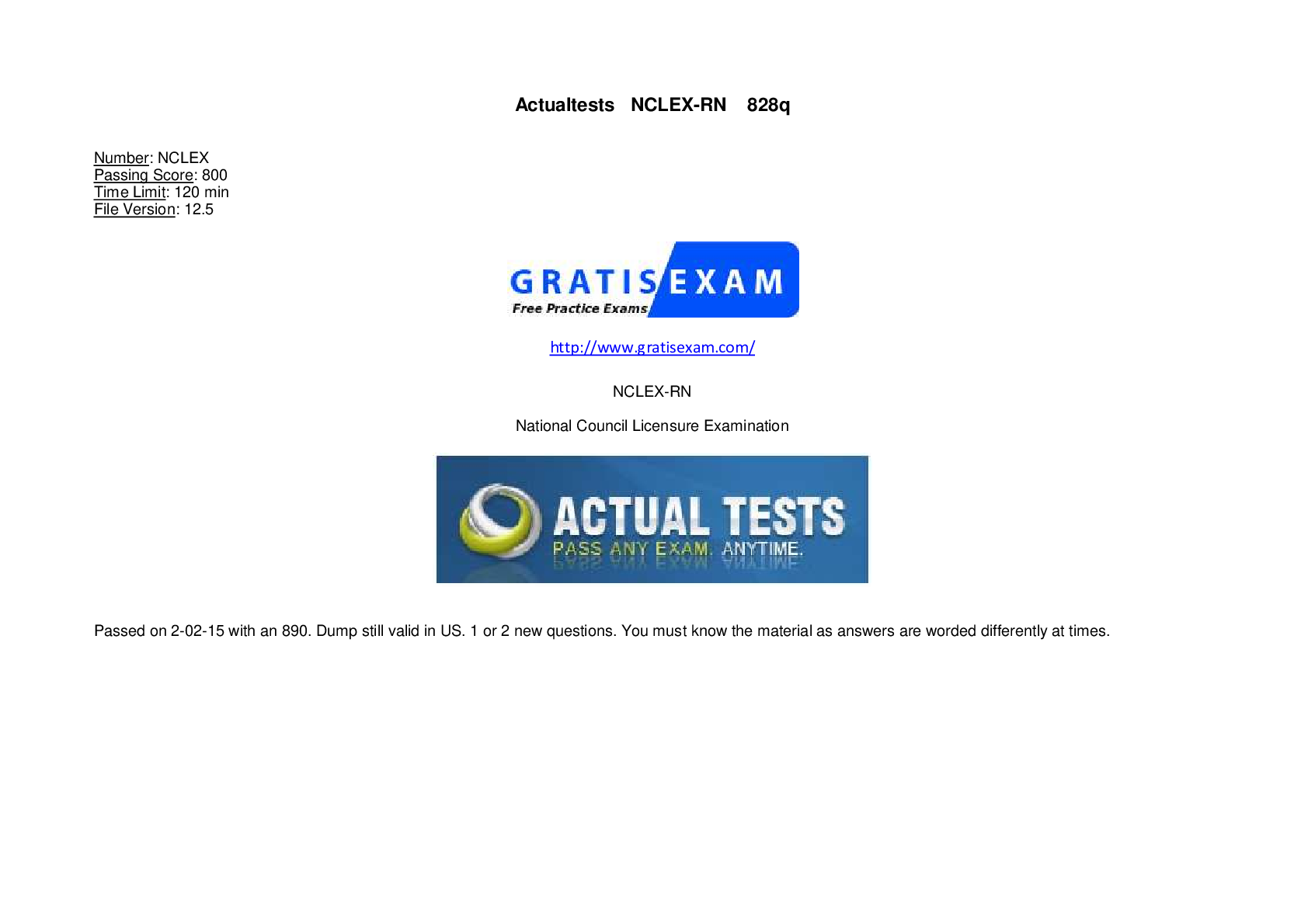
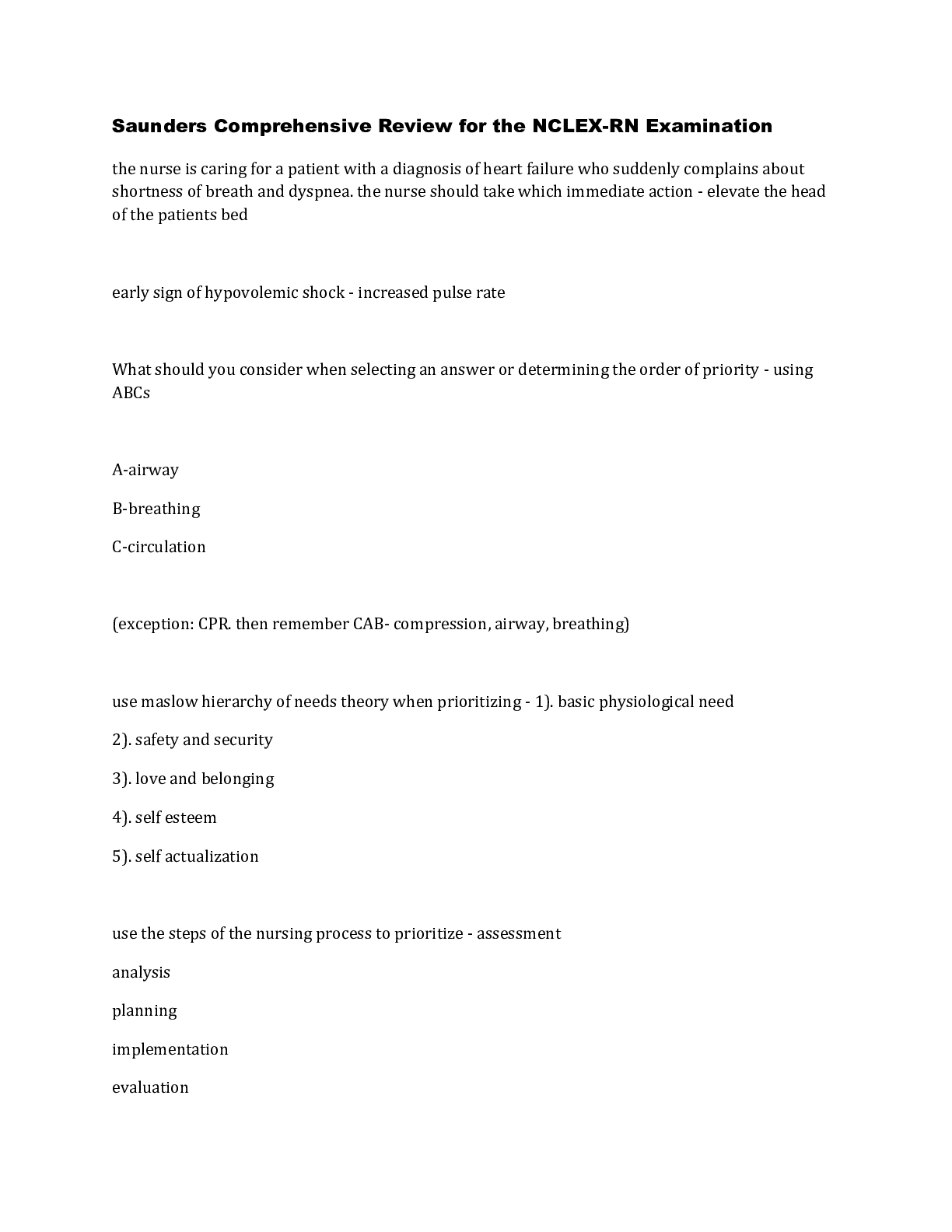


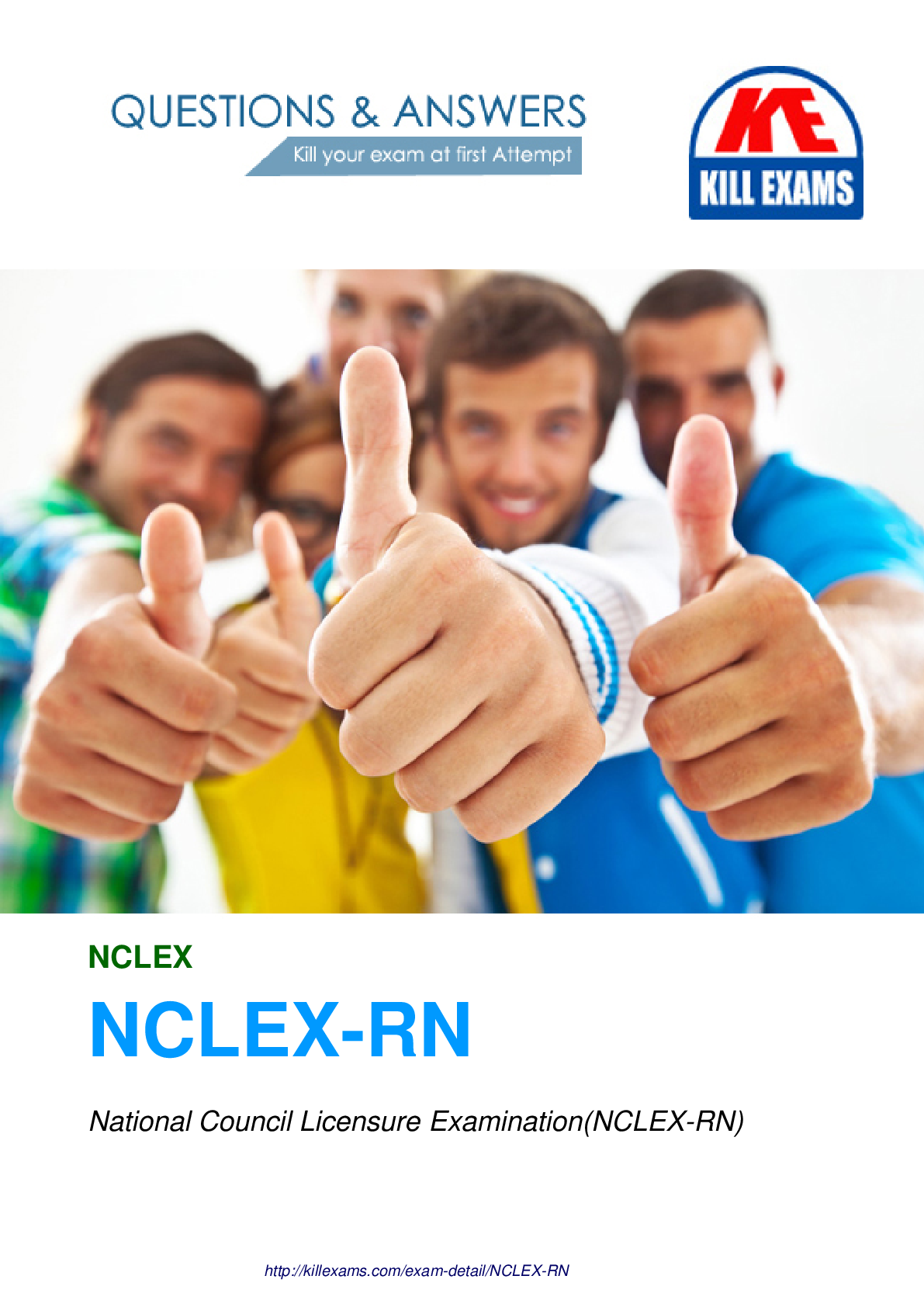
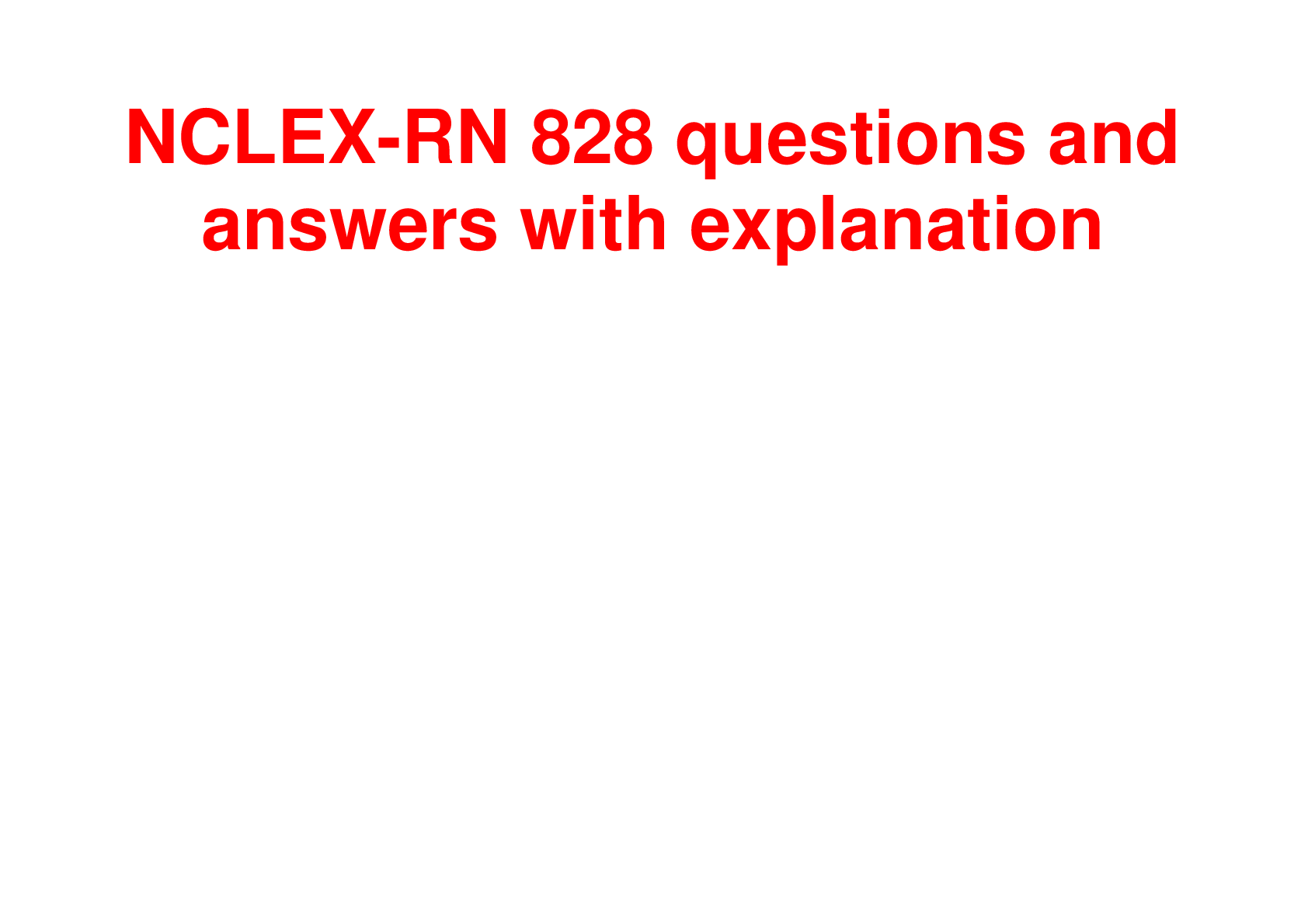
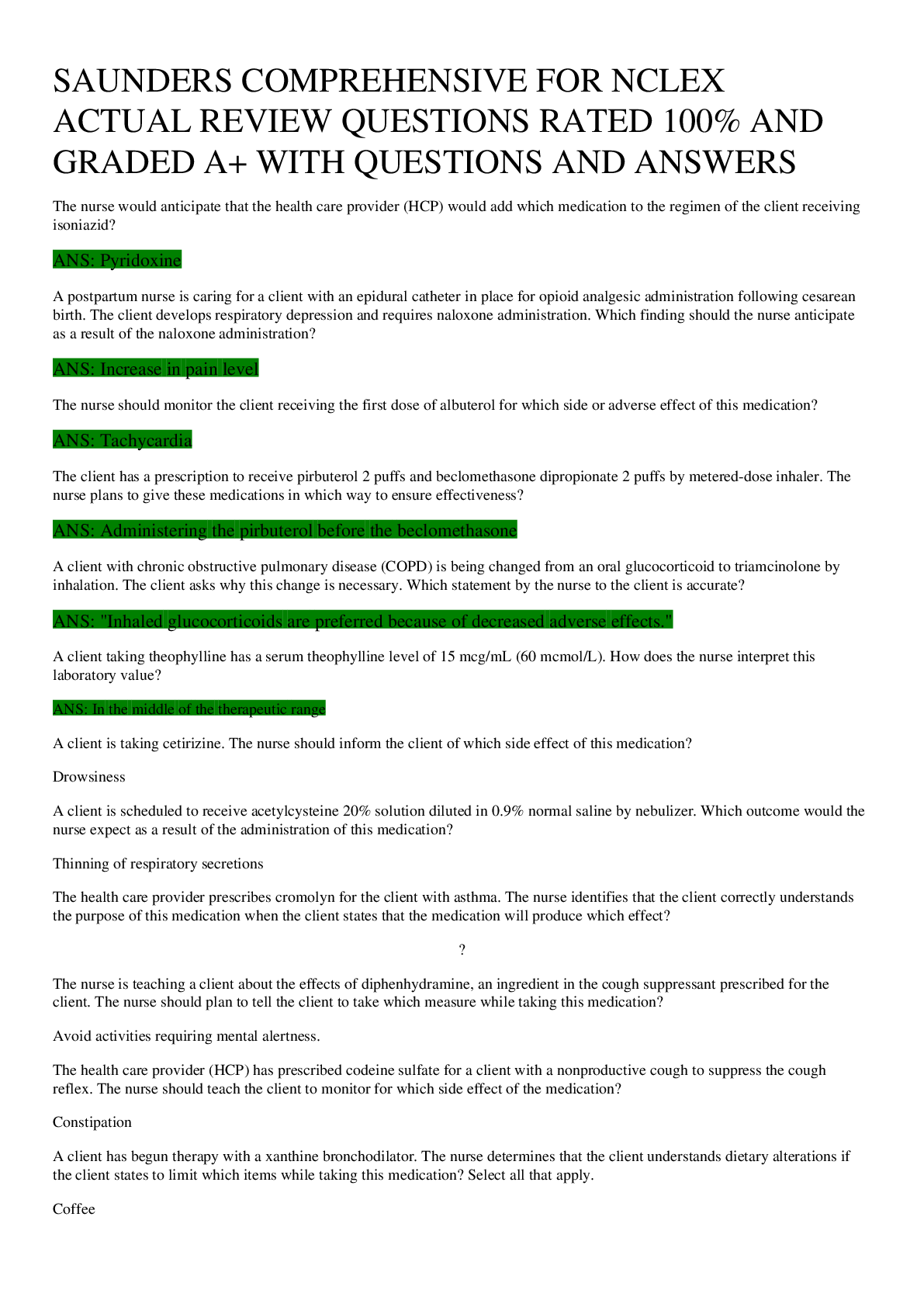
 With 850 Questions And Answers Guaranteed 100% Grade A.png)
